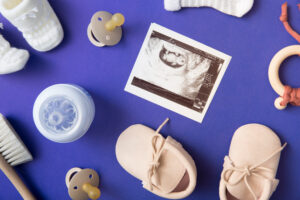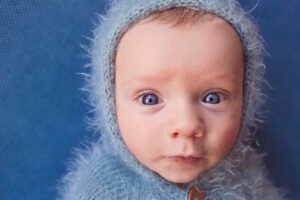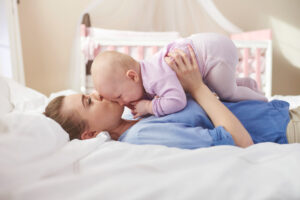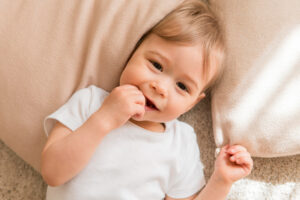A newborn is any baby less than 28 days old. Newborns need frequent baths until their umbilical cord falls off, or for boys that their circumcision heals.
The first step in a newborn bath is to gather your supplies and prepare the area for baby care. Make sure the water is comfortably warm and have a towel ready to dry your baby after bathing your baby.
Bathing Techniques
Bathing a newborn requires special techniques to keep baby safe and comfortable. To start, gather all your supplies and find a flat surface on which to lay baby. This could be a changing table, bed, kitchen counter or other sturdy surface. If you want, enlist the help of a partner or another family member to ensure that your little one doesn’t fall.
Next, fill a tub or sink with about two to three inches of warm water. Ideally, the temperature should be between 90 and 100 degrees Fahrenheit (and never hotter). You can check the water temperature with a thermometer before submerging your baby in the tub.
Using a washcloth, gently wipe baby’s face, head and neck, paying special attention to the ear creases and neck folds. Make sure to wash around the umbilical cord stump, if there is one, as well. Then move on to the arms, legs and torso, again concentrating on skin folds and creases.
Finally, rinse the rest of baby’s body. Make sure to wash the diaper area thoroughly, as bacteria can easily hide in these areas. After you’ve washed baby’s entire body, lightly pat her dry with a clean towel, going over the same areas again in the order that you washed them. Skip the lotions and powders, which can irritate baby’s sensitive skin. Instead, you can try Vaseline or Aquaphor for any dry patches of skin.
Techniques for Bathing a Sponge Bath
Newborns can benefit from alternative bathing methods that allow for skin-to-skin bonding and leave the coating of waxy vernix on their skin longer. A sponge bath can be done in a sink, tub, or a basin filled with lukewarm water. Before beginning, make sure you have gathered all your supplies, including towels, washcloths, shampoo/body wash, and newborn baby clothes.
Start by dipping a washcloth in the warm water and wringing out the excess water. Gently wipe down your newborn’s face, making sure to avoid their ears and nose. Then gently wash their body, avoiding the areas that may be sensitive or raw such as their legs and arms. After washing their body, make sure you dry them thoroughly with a clean washcloth. If your newborn has a cord stump, gently wash around it and pat it dry. It should fall off in about 5-15 days, but if it doesn’t, speak to your doctor.
After your newborn is completely dry, you can begin to wash their hair. Be sure to use mild soap or baby shampoo and only a small amount of it. Soap can irritate your newborn’s skin and cause itching, so less is often better. If your newborn is fussy during this time, try giving them a quick shower instead and returning to the bath later in the day.
Techniques for Bathing a Tub Bath
Bath time boosts bonding with newborns. It’s a great time to gaze into their eyes, kiss their little faces and count their tiny toes. Babies often respond well to being rocked, singing or having their hands held during the washing process.
Begin a sponge bath by filling the bathtub with two to three inches of warm water. It’s okay to add soap, but keep in mind that newborns don’t need a lot of washing (two or three times per week is usually fine). Wrap baby in a towel and uncover only the parts of their body you are actively washing. Be careful not to get water in the eye or mouth.
Once you’ve washed the face and hands, use a clean cotton ball to gently cleanse the eyes (starting from the inside corner of the eyes). Then wash the rest of their body. Remember to carefully wash the area around the cord stump and wipe away any crustiness. Finish up by cleaning their legs, arms and torso, paying special attention to skin creases and folds.
Once you’re finished, gently pat their skin dry and cover them in a soft, warm towel. Babies tend to lose body heat quickly, so it’s important to take extra precautions to keep them warm after a bath. Also, it’s best not to leave your newborn alone in the tub — even for a moment.
Techniques for Bathing a Washcloth Bath
Before beginning the bath, have everything ready: a basin of warm water (about body temperature), a washcloth rinsed in soap-free water, and a towel. Make sure baby is comfortable, wrapped in a towel on a soft surface (change table, bed, floor), and that the bath is in a room with good lighting and no distracting noises.
Begin by washing baby’s head. Be careful around the umbilical cord stump, and gently wipe away any crusty areas. Next, carefully wash the rest of baby’s body, being very thorough with creases and skin folds. Remember to wash behind ears, in ear crevices, and between fingers. Don’t forget to wash the diaper area well, too.
Be sure to use gentle soap. Newborns don’t need a lot of soap to stay clean, and too much can dry out the skin.
Once baby’s hands, feet, and torso are thoroughly washed, wash the face and head. Don’t forget to gently clean under the arms, between the fingers and toes, and the backs of the knees.
Once the body is completely washed, lightly pat baby’s skin dry with a towel. Avoid slathering on lotion, as newborns have very delicate skin and may get irritated by it. Instead, try using micellar water (like Mustela No Rinse Cleansing Water) to keep baby’s skin fresh and moisturized without a harsh soap.





